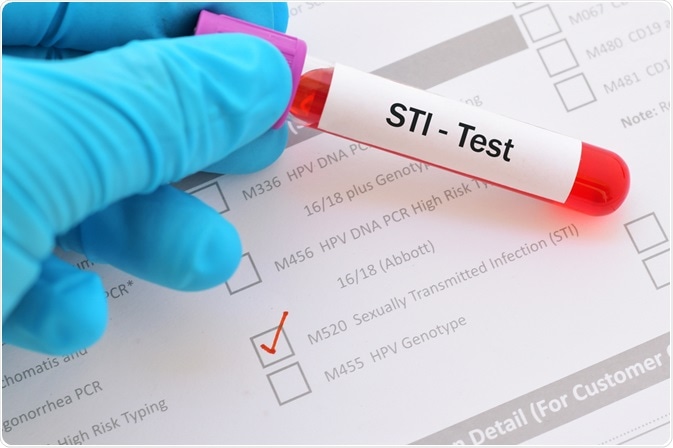Female sexual dysfunction (FSD) is defined as any distress that is the result of sexual pain, orgasm difficulties, and/or altered sexual interest or arousal.

Image Credit: NDAB Creativity/Shutterstock.com
Defining FSD
Complex interactions between both biological and psychosocial systems create the human sexual response. Some factors that can influence the sexual response include cultural practices, the individuals themselves, as well as the time, setting, and circumstance surrounding the sexual encounter.
Due to the high variability that exists in the definitions and diagnostic categories of female sexual dysfunction (FSD), there are limited data available on the incidence and prevalence of these disorders.
Even so, the incidence of FSDs has been estimated to be within the range of 25.8% to as much as 91%. More specifically, a 2006 study found that 64% and 31% of women experience desire and arousal difficulties, respectively, whereas 35% report orgasmic dysfunctions, and 21% experience sexual pain.
Types
FSDs can be divided into two categories including those that result in alterations in a woman’s sexual interest and/or arousal, those that affect the woman’s ability to reach orgasm, and sexual pain disorders.
Sexual interest and arousal FSDs
FSDs that alter a woman’s sexual interest and/or arousal can be further classified into three types, of which include female hypoactive sexual desire disorder (HSDD), female sexual arousal disorder (FSAD), and female sexual interest/arousal disorder (FSAID).
HSDD is categorized by a distressing low sexual desire that is not the result of a medical or psychiatric condition, or substance abuse. Comparatively, FSAD is defined as an inability to attain and/or maintain genital arousal consistently, despite receiving adequate stimulation.
As of 2013, FSIAD was introduced as a new FSD category that is the combination of both the altered desire symptoms of HSSD and the insufficient arousal element of FSAD.
Female orgasmic disorders
Another category of FSDs includes female orgasmic disorders (FODs), which are the second most prevalent type of sexual disorder in women. FODs are defined as the difficulty, delay, or inability to reach orgasm during sexual activity. An orgasm is defined as a sensation of intense pleasure, well-being, and positive feelings that results from a physiologic reaction.
In addition to these sensations, an orgasm is also accompanied by involuntary rhythmic contractions of the pelvic striated vaginal musculature, uterus and/or anus, an altered state of consciousness, and also a reduction in sexually induced vasocongestion levels. Neurologically, orgasms have been found to increase activation within the paraventricular nucleus of the hypothalamus, periaqueductal gray area of the midbrain, hippocampus, and cerebellum.
Sexual pain
There are currently four clinical conditions that are considered as female sexual pain disorders, which include dyspareunia, vaginismus, vestibulodynia, and vulvodynia. Dyspareunia, which is defined as genital pain during and/or after sexual intercourse, is estimated to have a prevalence within the range of 6.5% to 45% in older women and between 14% and 35% in younger women.
Vaginismus, which causes the involuntary spasm and/or tension of the perineal and levator muscles, makes penetration extremely difficult and, in some cases, not possible. Vestibulodynia causes severe pain in the woman that can arise upon touch or attempted vaginal entry within the vestibule. Lastly, vulvodynia is associated with chronic neuropathic-like pain within the vulvar area. The pain caused by vulvodynia can persist independent of physical contact.
Regardless of the type of female sexual pain disorder, it is crucial for treating clinicians to complete a comprehensive pain and psychosocial assessment for their patients. These assessments should include the use of rating scales to allow clinicians to establish a baseline and track patient progress over time.
Causes
Several different factors must be taken into consideration to determine the cause(s) for FSD. Under the umbrella of medical and surgical conditions that can lead to FSD include endocrine disorders, malignancies, particularly those due to breast and ovarian cancers, inflammatory diseases such as fibromyalgia and rheumatoid arthritis, as well as various neurological conditions, such as multiple sclerosis (MS).
Aside from these primary medical conditions exist several secondary, or acquired, problems that can also contribute to FSDs. Some examples of secondary problems include childbirth, hormonal changes, menopause, breastfeeding, and trauma.
FSDs can also result from various psychological conditions including depression, anxiety, and a previous history of sexual abuse. A negative attitude toward sex and/or negative body image, as well as the individual’s sexual orientation and type of sexual practices, can also contribute to their FSD.
In addition to being a possible cause of FSD themselves, the medications used to treat certain psychological disorders, such as antidepressants, antipsychotics, and hormonal birth control medications can also cause FSDs. A lack of exercise, unhealthy dietary habits, a history of smoking, alcohol use, substance abuse, and being overweight are all lifestyle factors that can also contribute to FSDs.
Additionally, certain psychosocial factors including age, education, income, and ethnicity can also affect a woman’s sexual functioning.
Outside of these causes, FSDs related to sexual pain may arise from a wide range of anatomic and functional causes, which can be further classified into irritative, anatomic, or infectious. For example, irritative causes of female sexual pain can include poor lubrication, atrophic vaginitis, vulvar dermatoses, and vulvodynia.
Infectious causes, on the other hand, can include a history of sexually transmitted infections (STIs), particular gonorrhea and chlamydia, as well as other types of non-STI pelvic inflammatory diseases like chlamydial vulvovaginitis.

Image Credit: Jarun Ontakrai/Shutterstock.com
Diagnosis
Clinicians often face several challenges in the diagnosis and treatment of women with FSD, of which include the woman’s discomfort with the topic, reproductive-focused cultures, as well as the limited resources for the clinician, such as a lack of training in this area and/or time constraints to acquire an adequate sexual history for the patient.
When a clinician is presented with a potential FSD case, they must be able to identify whether the patient is suffering from a sexual disorder or is in a transient state that is secondary to a relationship conflict or other temporary sexual problems.
Except for medication- and substance-induced sexual dysfunction, sexual dysfunction disorder diagnosis requires a minimum duration of 6 months of symptoms, during which the symptoms must be present 75% to 100% of the time.
Additionally, all symptoms must cause significant stress in the individual’s life to render an FSD diagnosis. The goal of these criteria is to eliminate the inclusions of individuals who are experiencing mild to moderate symptoms.
Treatment
Several different therapeutic approaches are available for the management of FSDs. For FSDs that are related to sexual desire or arousal, hormonal and/or non-hormonal treatment modalities are available. Some of the hormonal treatments that can be used to improve the symptoms of HSDD and FSAD include systemic or vaginal estrogen treatment, androgen supplementation, or selective estrogen receptor modulators (SERMs).
Nonhormonal treatment options for FSAD and HSDD include psychotherapy, serotonin agonists, dopaminergic drugs, phosphodiesterase 5 (PDE5) inhibitors, the Eros-Clitoral Therapy Device (Eros-CTD), antidepressants, and nutritional supplements.
The treatment of FODs are limited, as current management strategies are limited to cognitive behavioral therapy (CBT). This type of therapeutic approach is focused on reducing the occurrence of anxiety-provoking thoughts that might lead to sexual difficulties and instead divert the woman’s attention to increasing intimacy and trust.
Additional practices that may improve FOD symptoms include Kegel exercises, bibliotherapy, communications skills training, and direct clitoral stimulation.
References and Further Reading
- Clayton, A. H., & Juarez, E. M. J. (2019). Female Sexual Dysfunction. Medical Clinics of North American 103(4); 681-698. doi:10.1016/j.mcna.2019.02.008.
- Caruso, S., & Di Pasqua, S. (2019). Update on pharmacological management of female sexual dysfunctions. Sexologies 28(2); e1-e5. doi:10.1016/j.sexol.2019.02.002.
- Millman, A. L., Rebullar, K., Millman, R. D., & Krakowsky, Y. (2020). Female Sexual Dysfunction – Awareness and Education Among Resident Physicians. Urology. doi:10.1016/j.urology.2020.05.055.
Last Updated: Sep 1, 2020